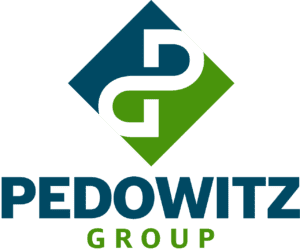ABM has become a major enterprise buzzword over the last decade, and your company is likely to have its own definition.
But, according to ISTMA, who coined the term, “Account-based marketing (ABM) is a strategic approach to designing and executing highly-targeted, personalized marketing programs and initiatives to drive business growth and impact with specific, named accounts.”
With all the buzz around ABM, you may be asking: “What’s the secret behind a successful ABM strategy?”
As many enterprises have discovered, there is no magic recipe for ABM. It requires a lot of preparation you may not have accounted for. Here are some readiness-related questions you may want to consider:
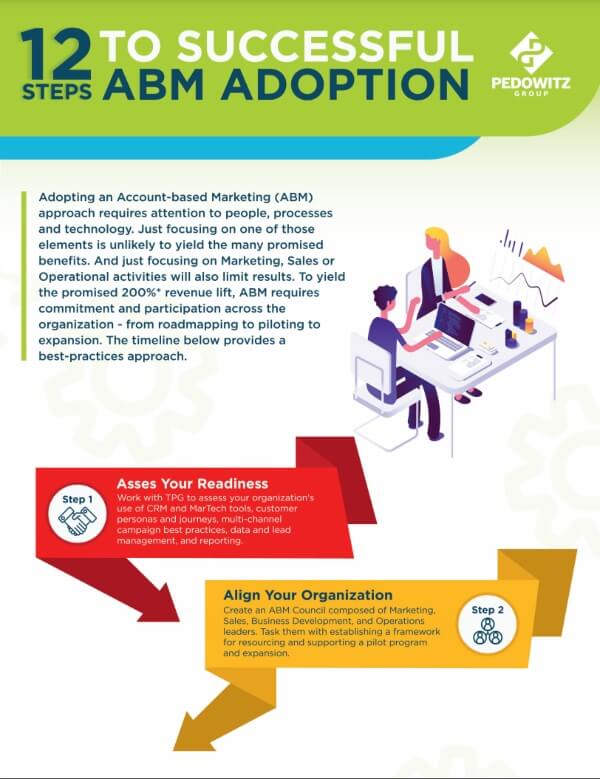
- Does your company have a Marketing Automation Platform fully-integrated with its CRM?
- Do you trust your database?
- Is your company targeting its sales efforts at a known/defined set of companies?
- Does your company design different campaigns for key segments or personas?
- Can Marketing deploy multi-touch, multi-channel campaigns?
- Does your company have content directed at different targets?
- Is content directed to different stages in the buying journey?
- Do Sales and Marketing collaborate to create and close key opportunities?
- Can you track Target Account Pipelines across Marketing and Sales?
- Will Sales and Marketing leadership sponsor and participate?
After seeing that deal-breaker list, you may be wondering if your organization is ready to adopt an Account-Based Marketing strategy. Don’t worry; any enterprise can benefit from key concepts.
Here are three important pillars to benefit your company while addressing some of the most difficult deal-breakers:
- Identify Your Ideal Customer – Create your Ideal Customer Profile and use it as a yardstick. Hold all your accounts up to it and tag those that match best for personalization.
- Conduct Multiple Conversations – Plot concurrent buying journeys for buying committee personas, including which assets each Buying Center Persona will be offered – and how.
- Play Together Nicely – Orchestrate cross-functional sales plays between Marketing, Inside Sales and Field Sales.
Let’s unpack each of these.
Lesson 1: Identify Your Ideal Customer
The Ideal Customer Profile (ICP) is a key ABM concept. An ICP is a detailed description of a prospective client that would benefit greatly from your product or service. It’s a yardstick that you measure your accounts against to determine which to cultivate through personalization (more on this later).
To arrive at your ICP, consider your company’s best clients: attributes such as industry, size, location, and profitability. Knowing which are the easiest and best to sell to is a must, as well.
Many enterprises know their target industries but have undefined markets within. Marketing may be trying to sell to the total addressable market – when Sales knows that some clients are worth more effort than others.
If you don’t have enough data to judge, you probably need to improve your customer intelligence before developing a full-scale ABM strategy.
Want more? Our deep dive into mapping the customer journey is for you.
By identifying your Ideal Customer Profile and targets like it, Marketing and Sales can focus on the key accounts.
But, it’s not as simple as just asking a few seasoned sales guys who the key accounts are. Here are some steps to follow:
Create a top ten list of customer accounts in each of the following categories:
- Highest spend/profitability
- Most satisfied
- Best to sell to
- Longest lifespan / Lifetime value
Weight each based on the following criterion:
- Industry you have the best track record with
- Geography you can support best
- Annual revenue & growth potential
- Likelihood to need your profitable products
- Technology they use
- Level of technology maturity
- Number of Employees
- Size of customer base
- Corporate-level goals
- Length of their sales cycle
Then, do the math. The account with the highest score is your ICP or yardstick. Others may be close runners-up. You may even discover you don’t know enough about some accounts, in which case data enrichment may be required.
Lesson 2: Conduct Multiple Conversations
Once you have identified your company’s Ideal Customer Profile and have assessed institutional knowledge about potential target accounts, use both to weight the strongest contenders and assign tiers. Those with a good ICP match and lots of institutional knowledge may warrant a strategic ABM approach.
Conversely, the less you know about an account, the more traditional your marketing approach should be.
The Styles of ABM are:
- Traditional marketing for named accounts
- Programmatic ABM for one-to-many marketing, often customized by the industry
- Scale ABM for one-to-few customized marketing to key roles in your top 100 accounts
- Strategic ABM for one-to-one personalized marketing to your top 10 accounts and key contacts therein
Many companies start with a mixed-tier approach in which they handle a top-few ICP-like accounts with white gloves and the rest with traditional or programmatic marketing.
Related: Our Starting Guide to Account-Based Marketing For Marketing Leaders
Understand buying committee personas (BCPs) within your ICPs
BCPs are a key Account-Based Marketing strategy that is often overlooked. After you have identified your target accounts by tier, you should consider roles within those targets.
Buying Committees or Centers are common in enterprises preparing to make large investments. Each participant has a committee role to play and needs decision-making information tailored to them.
Because another acronym is always nice, we’ll call these roles Buying Center Personas, or BCPs for short.
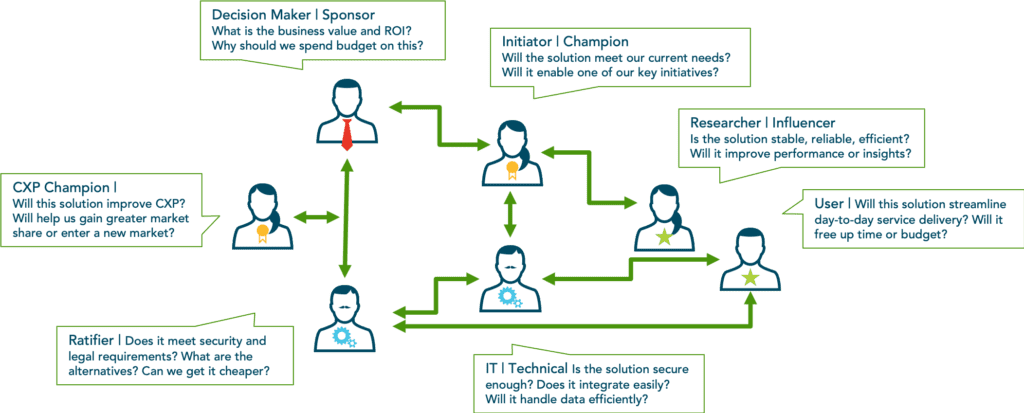
While the Champion who got you in the door may require constant nurturing, other BCPs may come into play at later stages and need specific information. For example, Security and Compliance ratifiers may need product specifications in various formats.
Though Revenue Marketing is an infinite customer experience loop, a more linear view (like the chart below) may assist with planning by helping stakeholders visualize the journeys within a buying committee.
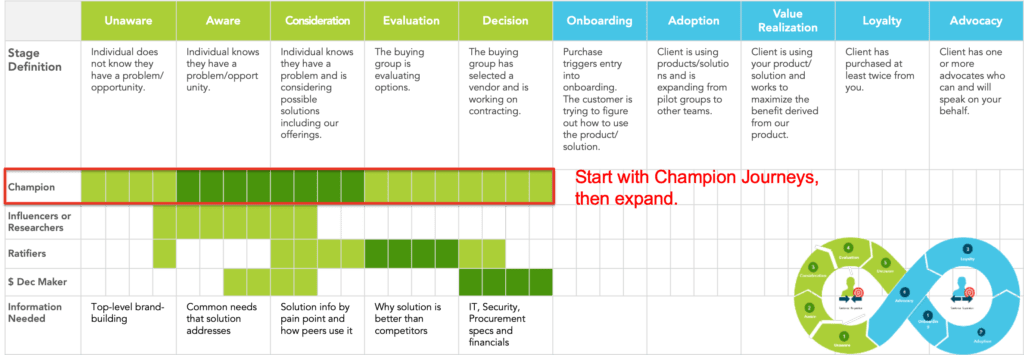
Consider taking some experienced Marketing and Sales stakeholders through an exercise to model the journeys. This will help clarify when BCPs participate and what information/content needs each has. You may discover a need to create more stage-specific content or to develop several similar, but distinct, campaigns running in parallel. Most importantly, consider which type of content and which channels will be most effective for each BCP.
Finally, consider which type of content and which channels will be most effective for each BCP. A template like this can help you prioritize content development based on value and effort:
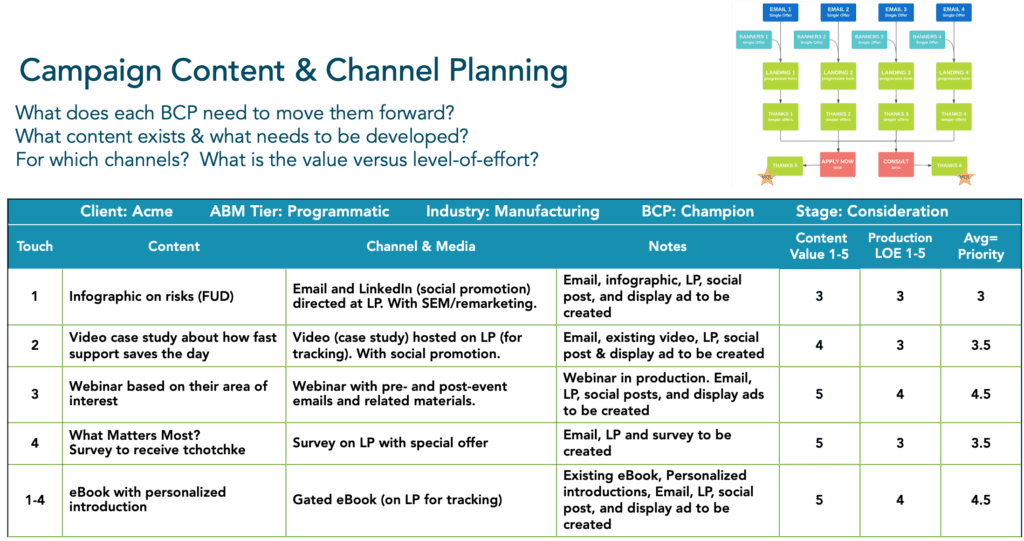
Create Coordinated BCP Journeys – The Right Message at the Right Time
Each BCP journey may be different, but should be coordinated to work together in order to maximize the account opportunity. Personalization plays an important role here. Instead of sending the same content to each person on the buying committee, consider tailoring the copy as well as content offers.
Acknowledge each BCP’s pain points, role and information needs. If possible, offer custom content.
- A Champion or Decision Maker may respond to a recorded webinar with an introduction for their company. An eBook with a custom cover letter and highlighted sections can be equally as effective.
- A technical or security ratifier might need both design specs and implementation use cases.
- Procurement and Legal may work best when you offer your documents on “their paper”.
Targeted media should support these messages.
Sometimes, contacts hold multiple BCP roles and could receive overlapping touches, so account monitoring is crucial. Sound like a lot more work than “batch-and-blast”?
With dynamic content, program cloning, and Digital Asset Managers, personalization no longer means starting from scratch for each BCP. But it will take more and more internal bandwidth as you hone in on your ABM target accounts. Personal conversations take more time, but they are worth their weight in lifetime value.
Lesson 3: Play Together Nicely
For the purposes of exploring this concept, let’s consider the customer experience. Imagine that Marketing has taken it upon themselves to identify key BCPs within key accounts and has nurtured each according to their information needs. Then, an unaware BDR or Field Sales rep calls the account for a random conversation. Or, an event presentation contradicts the communications with a different message entirely.
Does that look coordinated to the customer? Not so much. This deep dive on Customer Experience explains how dire this disconnect can be. Hence, this third concept you can (and should) consider orchestration.
Without it, you’ll never have a successful ABM program.
Coordinate Sales and Marketing Activities in any Account-Based Marketing Strategy
Coordinating cross-functional plays for key ICP accounts creates the optimum customer experience. To coordinate, each client-facing internal team has a role to play in moving the BCP journeys forward. Marketing, Sales and Sales Development all have assigned touchpoints and must be coordinated so the conversation is continuous. Kickoffs and regular touchpoints can be an effective way of making sure all teams are rowing together.
Events are a good place to start orchestration. Touches may range from personalized emails to custom landing pages, on-site hosting to personal follow-up. To be most effective, these touches need to be well-staged and well-executed.
It’s a good idea to map out touchpoints and tools so everyone is clear about their role. For example, many SDR teams like to use cadence marketing tools such as SalesLoft and Outreach. That’s fine, so long as their scripts match the marketing messages, support the journeys, and follow campaign timelines. The last thing you want is an SDR calling a key account BCP about something totally irrelevant. The same goes for Sales handling after the SDR handoff.
The idea is to play together.
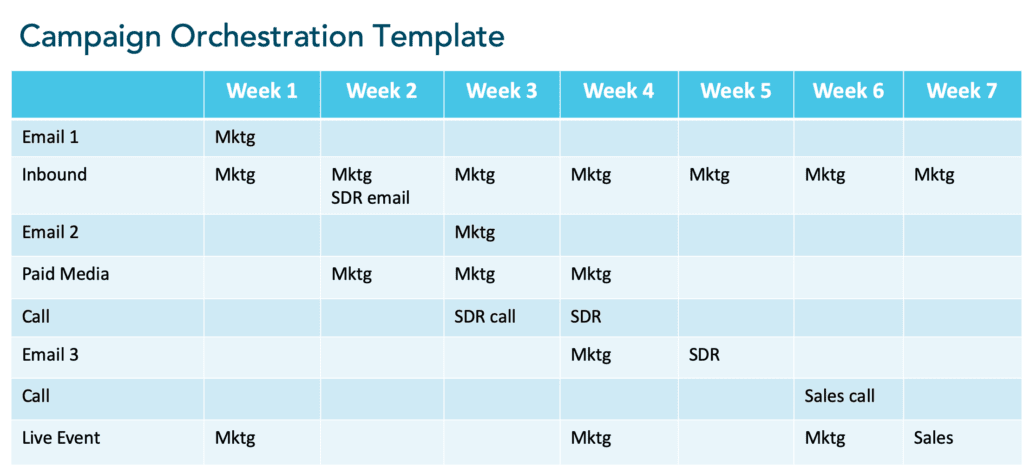
Closing Thoughts, and a Few Questions to Consider
To conclude, many enterprise leaders think ABM is as simple as picking their best accounts and giving them extra marketing and sales attention. But this can lead to incorrect messaging, uncoordinated activities, and a result that doesn’t resonate with your customers.
If it seems like your organization might need more time to get ready, consider starting with the three concepts we’ve explored in this blog: ICPs, BCPs, and Orchestration. Moving forward with these three ABM techniques will help your company prepare for ABM’s many benefits, including maximum lifetime value from your best accounts.
As your organization matures its ABM capabilities, you may want to replace these core capabilities with a tool like Forrester New Wave 2020 Leader 6Sense, which picks up intent signals from across the B2B web and dynamically matches them to your client’s ICP, accounts, and personas.
AI-driven predictive capabilities then identify the in-market accounts and contacts to pursue and how. Practicing the fundamentals around ICPs, BCPs, and Orchestration will position you to take advantage of sophisticated tools and move your ABM program forward exponentially.
Next Steps
- Look into additional ABM resources, including my blog detailing how much tech you need for ABM
- Want to get more from your current ABM efforts? Our Account-Based Marketing consulting is for you!
